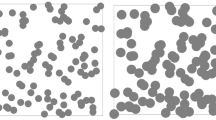Abstract
The covering location problem seeks the minimum number of facilities such that each demand point is within some given radius of its nearest facility. Such a model finds application mostly in locating emergency types of facilities. Since the problem is NP-hard in the plane, a common practice is to aggregate the demand points in order to reduce the computational burden. Aggregation makes the size of the problem more manageable but also introduces error. Identifying and controlling the magnitude of the error is the subject of this study. We suggest several aggregation methods with a priori error bounds, and conduct experiments to compare their performance. We find that the manner by which infeasibility is measured greatly affects the best choice of an aggregation method.
Similar content being viewed by others
References
Casillas, P.A. (1987). “Data Aggregation and the p-Median Problem in Continuous space.” In A. Ghosh and G. Rushton (eds.), Spatial Analysis and Location-Allocation Models. New York: Van Nostrand Reinhold Publishers, pp. 227-244.
Christofides, N. and P. Viola. (1971). “Optimum Location of Multi-Centers on a Graph.” Operations Research Quarterly 22(2) 145–154.
Current, J.R. and D.A. Schilling. (1987). “Elimination of Source A and B Errors in p-Median Location Problems.” Geographical Analysis 19, 95–110.
Current, J.R. and D.A. Schilling. (1990). “Analysis of Errors due to Demand Data Aggregation in the Set Covering and Maximal Covering Location Problems.” Geographical Analysis 22, 116–126.
Daskin, M.S., A.E. Haghani, M. Khanal, and C. Malandraki. (1989). “Aggregation Effects in Maximum Covering Models.” Annals of Operations Research 18, 115–139.
Daskin, M.S. (1995). Network and Discrete Location: Models, Algorithms and Applications. New York: John Wiley and Sons, Inc.
Drezner, Z. (1995). Facility Location: A Survey of Applications and Methods. New York: Springer Series in Operations Research.
Drezner, Z. and H. Hamacher. (2002). Facility Location: Applications and Theory. Berlin: Springer Verlag.
Dyer, M. and A. Frieze. (1985). “A Simple Heuristic for the p-Center Problem.” Operations Research Letters 3(6), 285–288.
Erkut, E. and B. Bozkaya. (1999). “Analysis of Aggregation Errors for the p-Median Problem.” Computers and OR 26(10–11), 1075–1096.
Francis, R.L. and T.J. Lowe. (1992). “On Worst-Case Aggregation Analysis for Network Location Problems.” Annals of Operations Research 40, 229–246.
Francis, R.L., L.F. McGinnis, and J.A. White. (1992). Facility Layout and Location: An Analytical Approach, 2nd edition. New Jersey: Prentice Hall, Englewood Cliffs.
Francis, R.L., T.J. Lowe, and M.B. Rayco. (1996). “Row-Column Aggregation for Rectilinear Distance p-Median Problems.” Transportation Science 30, 160–174.
Francis, R.L., T.J. Lowe, G. Rushton, and M.B. Rayco. (1999). “A Synthesis of Aggregation Methods for Multi-Facility Location Problems: Strategies for Containing Error.” Geographical Analysis 31, 67–87.
Francis, R.L. and M.B. Rayco. (1996). “Asymptotically Optimal Aggregation for Some Unweighted p-Center Problems with Rectilinear Distances.” Studies in Locational Analysis 10, 25–36.
Francis, R.L., T.J. Lowe, and A. Tamir. (2000). “Aggregation Error Bounds for a Class of Location Models.” Operations Research 48, 294–307.
Francis, R.L., T.J. Lowe, and A. Tamir. (2004). “Demand Point Aggregation Analysis for a Class of Constrained Location Models: A Penalty Function Approach.” IIE Transactions 36, 601–609.
Goodchild, M.F. (1979). “The Aggregation Problem in Location-Allocation.” Geographical Analysis 11, 240–254.
Hakimi, S.L. (1965). “Optimal Distribution of Switching Centers in a Communications Network and Some Related Graph Theoretic Problems.” Operations Research 13, 462–475.
Hillsman, E.L. and R. Rhoda. (1978). “Errors in Measuring Distances from Populations to Service Centers.” Annals of Regional Science 12, 74–88.
Iyer, A.V. and H.D. Ratliff. (1990). “Hierarchical Solution of Network Flow Problems.” Networks 20(6), 731–752.
Kariv, O. and S.L. Hakimi. (1979). “An Algorithmic Approach to Network Location Problems Part I: The p-Centers.” SIAM Journal of Applied Mathematics 37, 513–538.
Karp, R.M. (1972). “Reducibility Among Combinatorial Problems.” In R.E. Miller and J.W. Thatcher (eds.), Complexity of Computer Computations. New York: Plenum Press, pp. 85–103.
Marianov, V. and C. ReVelle. (1995). “Siting Emergency Services in Facility Location: A Survey of Applications and Methods, Z.” In Drezner (ed.), Facility Location, a Survey of Applications and Methods. Springer-Verlag.
Masuyama, S., T. Ibaraki, and T. Hasegawa. (1981). “The Computational Complexity of the M-Center Problems on the Plane.” Transaction of the IECE of Japan 64(2), 57–64.
Megiddo, N. and K. Supowit. (1984). “On the Complexity of Some Common Geometric Location Problems.” SIAM J. Computing 13, 182–196.
Mirchandani, P.B. and R.L. Francis. (1990). Discrete Location Theory. John Wiley and Sons.
Minieka, E. (1970). “The m-Center Problem.” SIAM Rev 12, 138–139.
Nemhauser, G. and R.S. Garfinkel. (1972). Integer Programming. John Wiley and Sons.
Rayco, M.B., R.L. Francis, and T.J. Lowe. (1997). “Error-Bound Driven Demand Point Aggregation for the Rectilinear Distance p-Center Model.” Location Science 4, 213–235.
Rayco, M.B., R.L. Francis, and A. Tamir. (1999). “A p-Center Grid Positioning Aggregation Procedure.” Computers and Operations Research (Special Issue on Aggregation and Disaggregation for Operations Research) 26, 1113–1124.
ReVelle, C. (1989). “Review, Extension and Prediction in Emergency Service Siting Models.” European Journal of Operational Research 40, 58–69.
Schilling, D., V. Jayaraman, and R. Barkhi. (1993). “A Review of Covering Problems in Facility Location.” Location Science 1(1), 25–55.
Zhao, P. and R. Batta. (1999). “Analysis of Centroid Aggregation for the Euclidean Distance p-Median Problem.” European Journal of Operational Research 113, 147–168.
Zemel, E. (1985). “Probabilistic Analysis of Geometric Location Problems.” SIAM J. Algebraic and Discrete Methods 6(2), 189–200.
Author information
Authors and Affiliations
Corresponding author
Rights and permissions
About this article
Cite this article
Emir-Farinas, H., Francis, R.L. Demand Point Aggregation for Planar Covering Location Models. Ann Oper Res 136, 175–192 (2005). https://doi.org/10.1007/s10479-005-2044-2
Issue Date:
DOI: https://doi.org/10.1007/s10479-005-2044-2




